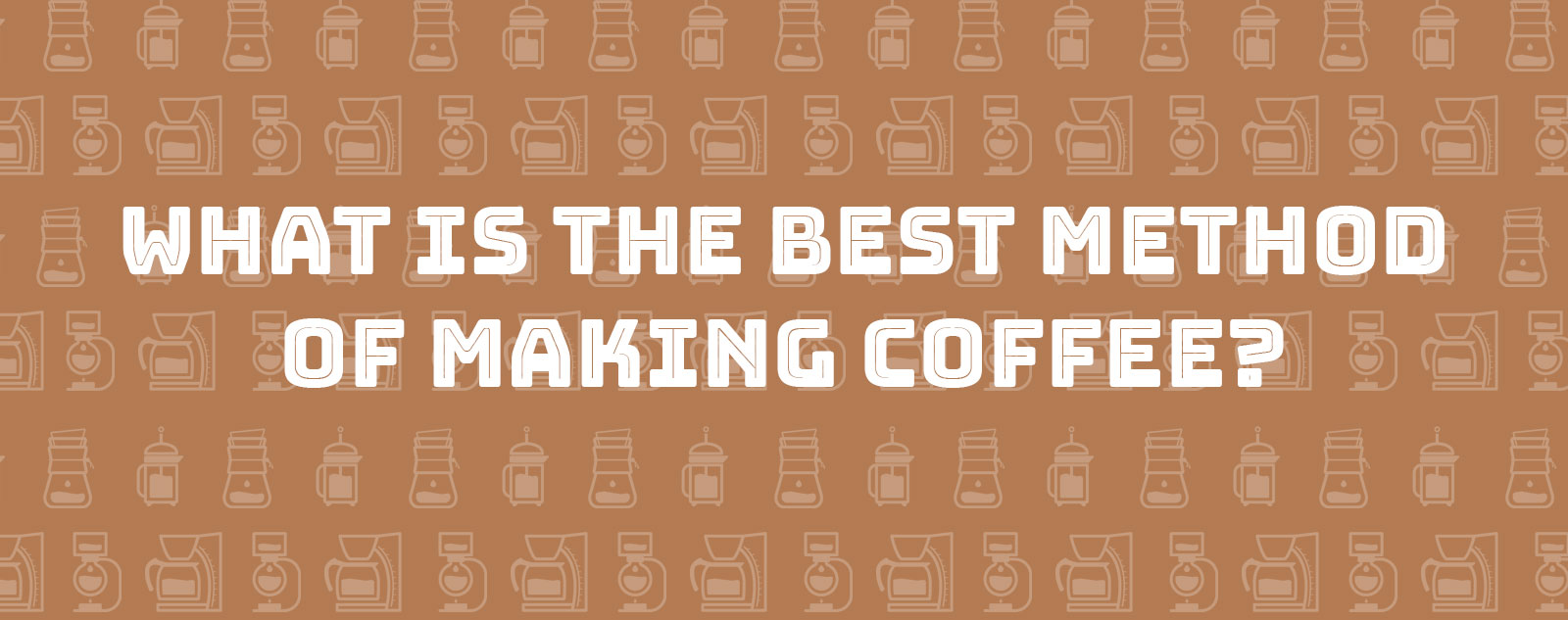What is the best method of making coffee?

One of the most important aspects of creating a mind-blowing cup of coffee is the instrument you choose to make it with and not all coffee makers are created equally. In this article, we will be running through some of the best brewing methods and breaking down the pros and cons of each. So study up and get ready to enjoy your ritual!
Before we jump into different coffee makers, we wanted to note a couple important aspects to keep in mind before you start. First, be sure to buy your coffee weekly instead of buying in bulk. Bulk coffee loses it’s taste while it sits, and that why we have made it easy to subscribe online for weekly deliveries with free shipping. Second, always grind your coffee right before you brew it. Ground coffee loses its taste at a rapid rate, and a good bur grinder only takes seconds to produce fresh grounds. Third, the template of your water matters so gets yourself an electric kettle with a setting for 200 degrees. It makes warming your water crazy fast and accurate every time.
French Press

The French Press, also known as the coffee plunger, is one of the most popular brewing methods due to its thick robust taste and easy use. It was invented 1929 by Paolini Ugo and is usually made of glass or clear plastic. One of the most important things to remember when using this tool is to get a rough grind on your beans. This is because the metal filter used to strain the grind is know to allow some grinds through if it is fine.
Pros
• Produces a strong cup of coffee with a robust taste
• Gives you a lot of control of strength and taste by the amount of time you let it sit before you push down the grounds.
• Can produce multiple cups of coffee at the same time, making it a great tool for impressing a group of friends.
• Good for the environment! It doesn’t use filters, so you don’t have to worry about waste.
• If you ever decide to switch it up with a little tea, this amazing tool has you covered and produces some of the best tasting cups of tea with loose tea leaves.
Cons
• Due to the wide metal strainer used to filter the coffee, the French press is known to allow a little sediment or sludge through even if you do a rough grind.
• You are helping to save the environment with the lack of paper filters, but it also makes cleanup a little harder than other coffee makers.
Grind Type: Coarse. You know those Raw sugar packets you see all over the place? It should look like that so it doesn’t fall through the strainer and make it to your cup. Also, if you notice that it is hard to push the filter down, you need to get a thicker grind.
Coffee Water Ratio: About 60–70 grams per liter of water.
How To Prepare: Add your grounds and hot water, wait about 4-5 minutes, and push the strainer down. If you let the coffee sit in the French Press for too long your coffee will take on a more bitter taste.
Pour-Over

If you are looking to impress yourself and everyone in your kitchen, look no further! The pour over is one of the purest ways to produce a clean tasting cup of coffee. Plus there are so many amazing looking Pour-Overs that will add class to your kitchen.
Pros
• It allows the natural flavors of your beans stand out so you get the most out of those high-quality Marea beans you just got shipped to your front door.
• It only takes a quick rinse in the sink to clean out the coffee maker.
• The fine paper filters used to strain sediment and oils make brewing fast and easy and help prevent bitterness and grinds from getting through to your cup.
• There are tons of pour over such as the Chemex that allow you to make multiple cups of coffee at the same time. This makes this method great for home or an office of a true coffee enthusiast.
• There is no better way to impress your morning after guest then making them a mind-blowing cup of coffee with one of these beautiful pieces of equipment.
Cons
• You will need to use paper filters every-time you make a cup of coffee. Fortunately, there are a lot of environmentally friendly filters out there that will keep the environment happy while doing the same for your taste buds.
• If you let your coffee sit in the coffee maker for too long, you will need a long brush to clean out the bottom.
• Most pour overs are not insulated, so you will need to enjoy your cup of coffee right after you make it ensures it stays warm.
Grind Type: Coarse. You know those Raw sugar packets you see all over the place? If you notice that water is not passing through fast enough, you might need to use a more coarse grind.
Coffee Water Ratio: Because this style varies in size, it is hard to For a six-cup Chemex, four or five tablespoons of grounds and about two and a half cups of water.
How-To: Wet the paper filter in the pour-over basket to wash away paper flavors and seal it in place, then dump that water out. Then add your grounds and slowly pour over the water. Use a gooseneck kettle to look cool – and, less importantly, to have optimal control over how fast and where you’re pouring the water.
How To Prepare: Between three and four minutes.
Capsule Machines

We know this is a fast and effective way to get caffeine into your body, but other than being a quick pick-me-up, we wouldn’t recommend this process. The most common name you will recognize for this style is the Keurig coffee maker.
Pros
• It’s quick and easy to make coffee.• There’s not much else to say…
Cons
• All that talk about how k-cups are destroying the environment is true. In 2014 enough K-Cups were sold to circle the earth 10.5 times and even though there are some k-cups out there that are recyclable, the majority are not and even the recyclables solutions create some waste.• They generally produce a thin cup of coffee with very little taste.
• They cost much more per cup of coffee.
Drip Machine
 Image By: https://www.yourbestdigs.com/reviews/best-drip-coffee-maker/
Image By: https://www.yourbestdigs.com/reviews/best-drip-coffee-maker/
These are the most common automatic coffee makers and do a solid job of creating a good cup of coffee for a larger group.
Pros
• Most of these can be programmed the night before to have a cup of coffee ready before you even wake up.• You can produce a lot of coffee at once out of some of the drip machines out there. So this can be a great solution for an office of thirsty coffee drinkers.
• Most of these machines have a warm plate under then to keep your coffee warm until you are ready to pour a new cup.
Cons
• This style generally doesn’t make as rich of a cup of coffee as a manual process.
• You will need to clean out the coffee maker every once-in-a-while with vinegar. This process can take a while.
• Mold is known to be produced in these machines unless you take time to clean them right after you make coffee.
How To Prepare: Every drip machine is different, so we suggest you follow the directions they provide for brewing and ratios.
Conclusion
Coffee is a ritual that brings comfort and positive vibes to your morning, so when it comes to making your daily cup, we are firm believers in the manual process. The French Press and the drip process will take a little extra time, but we promise that it's worth the end result.

